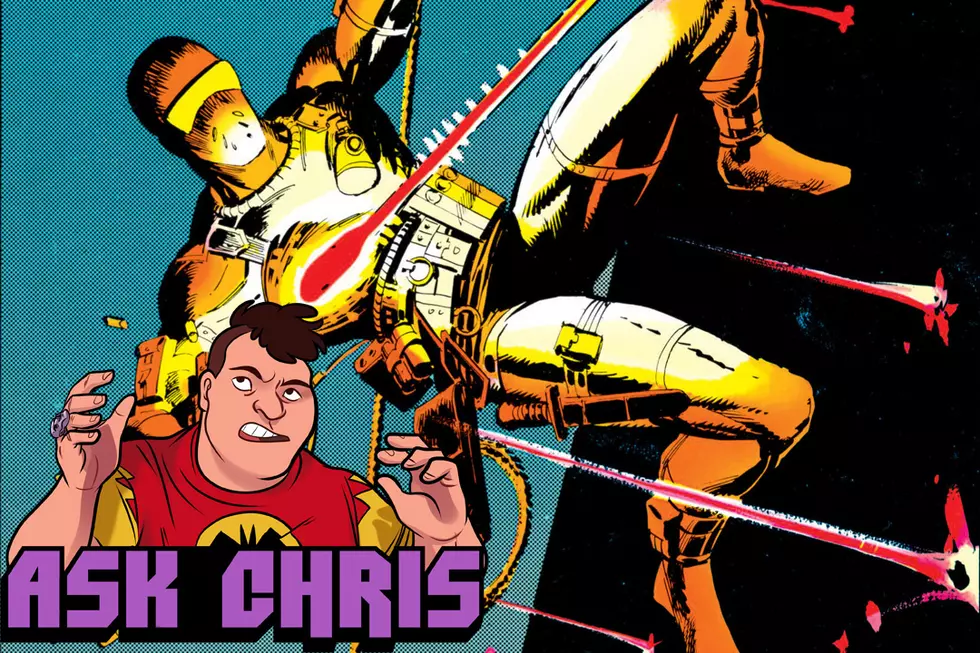
The Death Of Dr. Burkhardt: How I Was Emotionally Destroyed By An Issue Of ‘G.I. Joe’
So last weekend, I almost started crying while I was reading a G.I. Joe comic at the Waffle House.
Everyone I've told that to since it happened has reacted with the same complete and utter lack of surprise. I can see why, too, since it's quite possibly the single most cartoonishly on-brand thing that I've ever done, but I certainly wasn't expecting to get choked up over hash browns over the death of an extremely minor character. But when I was reading through G.I. Joe #204 over breakfast and Dr. Adele Burkhart was killed, ending a 32-year career of being rescued by the soldiers of America's most toyetic Special MIssions Force, it broke my heart in a way that hasn't happened through comics in a long, long time.
I should probably note that I've been spending the past couple of months reading the entirety of Larry Hama's run on G.I. Joe. When IDW released their anniversary edition of the classic "Silent Interlude" from Joe #21, I read it and then just kept on going with #22 until I'd made it through the whole thing, switching over to the current IDW series -- which picks up right where the Marvel run left off -- once I was through. And what I noticed more than anything else, the thing that made Burkhart's death hit me like a punch in the gut, was how seamless it is.
The Marvel run, where Hama wrote about 150 issues of a 155-issue run, plus another two dozen of Special Missions, was always like that. It was an incredible example of the long game school of plotting, and even when there were distinct stories, the events of that run flowed into each other with the kind of consistency that makes it feel "real" on a certain level, even when it's a book about a snake-themed terrorist organization that once made a clone out of history's greatest dictators and then dressed him up as a snake and gave him a flying podium to command from. It's a function of Hama being the driving force behind the book for the past 30 years, the same kind of structure that you can see in what Chris Claremont did on X-Men over the course of his two decades, or what John Wagner has done on Judge Dredd, where everything has significance and comes back over and over, because it all comes from a unified vision.
When IDW brought the book back and picked up from the original numbering, it felt the same way. Hama's scripts picked right back up where they let off, as though there hadn't been an eighteen-year gap between #155 and 156. Plot threads picked up, character arcs continued, and if you read it all together, it all felt like it had been going on all that time.
And Dr. Burkhart is there from the very first moment. She literally appears on page two of the first issue of G.I. Joe, before any of the heroes are named. She's the target of Cobra's first plot, a kidnapping that is, of course, foiled inby the end of the issue. In that first appearance, she's basically just there to get the plot rolling and show that the Joes are good soldiers even when they're called on to rescue someone who they might not agree with politically. She's a generically noble nuclear scientist who was mostly notable for being completely uncompromising even in the face of being threatened with death.
But instead of being a one-shot McGuffin, Dr. Burkart sticks around, evolving over the course of the series from a generic scientist to a political activist, a staunchly anti-military pacifist in a book that was all about these daring, highly trained soldiers and how great they were. It was the type of character development that could've easily made her an antagonist for the heroes, a thorn in their side who kept getting herself in dangerous situations and then turning out to be a weepy ingrate when the Joes showed up to do what was necessary to save her life.
And on one level, that's what she was.
But the trick to Hama's work on G.I. Joe is that it's surprisingly sophisticated for a book that's ostensibly made to sell toys, where the creators are tasked with taking pages away from their ongoing plots to introduce new playsets and toys for all the readers to bug their parents into buying for them, and that sophistication showed itself in the way that the Joes interacted with the people around them. Despite her tendency to wind up kidnapped by the forces of Cobra and her distrust of the military, Burhart was never portrayed as anything but principled and self-sacrificing. She was the other side of the coin to the Joes, going where she felt she could do the most good and doing it peacefully -- and even showing up to help them when they needed her support.
When the book came back at IDW, Dr. Burkhart came back with it, showing up early in the new run being kidnapped by pirates, then again just a few months ago in the Middle East, once again captured and held hostage while on a mission to promote education for women. Once again, Larry Hama and artist S.L. Gallant sent the Joes in for the rescue, but this time, it all goes sour, and after being injured, Burkhart is killed when she takes a bullet for one of the Joes during the firefight.
It's not the first time that they've killed off a character. There's that famous story where seven Joes are killed at once by the S.A.W. Viper, but to be honest, as much as I might like Doc and Quick Kick -- and folks, I love Quick Kick -- that whole story is pretty goofy in retrospect. It's so over-the-top that mourning those characters would be like getting all broken up when the cop who's two days away from retirement bites it in the first five minutes of a Schwarzenegger movie. Even when Cobra Commander's son, Billy, died -- which was arguably the most surprising moment of the IDW run, and one that was definitely the focal point of the storylines on either side of it -- it didn't hit me like Dr. Burkhart did.
And to be honest, I'm not sure why. With all due respect to the creators and a book that had an emotional impact on me, the actual beats of the story aren't really that distinct. It's the type of thing we've seen before from G.I. Joe, right down to the moment where Alpine refuses to leave her body behind, but this time, it wrecked me. Maybe it was because Burkhart represented a rejection of violence in a story that was based entirely around cartoonish war stories and having her die as a victim of that violence she'd spent so long fighting while staying true to her character worked better than I ever expected it to. Maybe it was just the shock of seeing the formula of seeing Burkhart get rescued over and over over the course of 200 issues turned on its head that made it feel bigger. Maybe waffles just make me emotional. Whatever it was, Adele Burkhart's death felt real, even though it happened in the same book where other characters were dealing with finding a giant alien eyeball buried in a secret base that was buried under their secret base.
But at the end of the day, that's the thing about comics. As weird as they are, as goofy as they can get, there's emotion in there that can ruin your day when you least expect it. And that's great.

More From ComicsAlliance
![The Dreadnoks Are Back At It Again In ‘GI Joe’ #3 [Preview]](http://townsquare.media/site/622/files/2017/03/GIJoe00.jpg?w=980&q=75)




![IDW Reveals ‘Revolution’ Titles For March, Including ‘Revolution: Aw Yeah!’ [Solicitations]](http://townsquare.media/site/622/files/2016/12/Rev00.jpg?w=980&q=75)

![The Crown Jewel Of The Hasbro Universe: Aubrey Sitterson On Rebuilding ‘GI Joe’ After ‘Revolution’ [Interview]](http://townsquare.media/site/622/files/2016/09/Joe00.jpg?w=980&q=75)
![Hasbro’s GI Joe and the Transformers Set is a Sticker-filled Throwback [Review]](http://townsquare.media/site/622/files/2016/09/IMG_0732.jpg?w=980&q=75)
